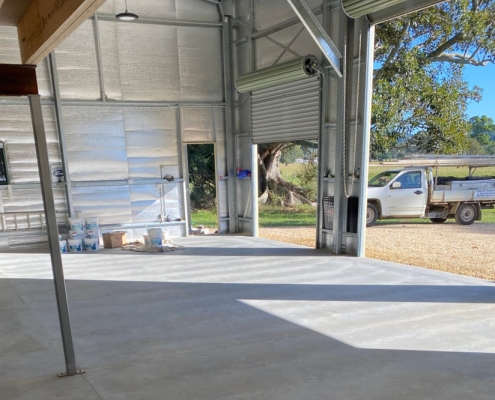Why Regular Roof Resprays Are Essential for Long-Lasting Protection
Your roof is one of the most important components of your home, acting as a barrier against the elements, from harsh sunlight to heavy rain and wind. Over time, even the most durable roofing materials can start to show signs of wear, which can compromise their protective qualities. This is where regular roof resprays come in. By maintaining your roof with periodic respraying, you can extend its lifespan, improve its appearance, and protect your property from costly repairs. In this article, we’ll explore why roof resprays are essential, what benefits they offer, and how to determine when your roof needs a fresh coat.
What is a Roof Respray?
A roof respray involves applying a new layer of protective coating or paint to the surface of your roof. This process helps restore colour, repair minor imperfections, and add a durable seal that protects against weather and wear. Roof respraying is suitable for a range of roofing materials, including tiles, concrete, metal, and Colourbond roofs, and it is an effective way to revitalise the appearance and function of your roof without a complete replacement.
Key Benefits of Regular Roof Resprays
1. Enhanced Protection Against the Elements
Roof respraying adds a durable protective layer that safeguards against weather damage. With exposure to intense UV rays, rain, wind, and temperature fluctuations, roofing materials naturally degrade over time. A respray with a high-quality, weather-resistant coating will help your roof withstand these elements, reducing the risk of leaks, cracks, and other damage.
2. Prolongs Roof Lifespan
Regular roof resprays can significantly extend the lifespan of your roof by reinforcing its structural integrity. The additional protective layer seals small cracks and prevents moisture from penetrating the surface. This extra care can delay the need for costly roof repairs or replacements, saving you money in the long run.
3. Prevents Mould and Mildew Growth
In damp climates, roofs are susceptible to mould and mildew growth, which can weaken the roof structure and pose health risks. Roof respraying often includes mould-resistant additives in the coating, helping to prevent these issues from developing. This keeps your roof clean, healthy, and free from harmful substances.
4. Enhances Curb Appeal
A freshly resprayed roof can dramatically improve the overall appearance of your home, increasing its curb appeal and adding to its value. Roofs naturally fade over time, making a property look aged. A roof respray can restore vibrant colour, giving your home a fresh, modern look without the expense of a full roof replacement.
5. Increases Energy Efficiency
Certain roof coatings used in respraying are designed to reflect UV rays, reducing heat absorption and keeping your home cooler. This reflective property can lower your home’s energy needs, particularly in warmer months, as it reduces reliance on air conditioning. Over time, this can lead to significant savings on your energy bills.
6. Cost-Effective Maintenance
Compared to a full roof replacement, a roof respray is far more affordable and less disruptive. By respraying your roof regularly, you’re performing preventive maintenance that addresses minor wear before it escalates into more serious and costly repairs.
7. Protects Against Rust and Corrosion
Metal and Colourbond roofs are especially prone to rust and corrosion, particularly in coastal areas with high salt exposure. Respraying adds a protective layer that shields against moisture, rust, and corrosion, helping metal roofs retain their strength and appearance.
Signs Your Roof Needs a Respray
Knowing when your roof needs a respray can help you stay ahead of potential issues. Here are some signs to look out for:
1. Fading or Discolouration
Fading is a natural consequence of UV exposure, but it can make your roof look worn and dated. If your roof’s colour has become dull or patchy, a respray can restore its original appearance and provide a protective layer against further sun damage.
2. Cracks or Small Leaks
Small cracks or leaks can develop over time, especially in older roofs or areas exposed to harsh weather. A roof respray can seal these minor imperfections, preventing water ingress and avoiding further deterioration.
3. Mould or Moss Growth
If you notice moss, mould, or mildew on your roof, it’s a sign that moisture is accumulating. Regular respraying with anti-fungal additives can help prevent this growth, maintaining a cleaner, healthier roof surface.
4. Peeling or Flaking Paint
For painted roofs, peeling or flaking paint is a clear sign that your roof’s protective layer has worn down. A fresh respray can repair these areas, improving both appearance and protection.
5. Rust Spots (for Metal Roofs)
Rust spots on metal roofs indicate that moisture is causing corrosion. Respraying your metal roof with a corrosion-resistant coating will help prevent further rusting and prolong the life of the roof.
Roof Respray Process: What to Expect
A professional roof respray involves several steps to ensure optimal results. Here’s what you can expect:
1. Inspection and Preparation
The first step is a thorough inspection to assess the roof’s condition, identify any necessary repairs, and recommend the best type of coating. Preparation includes cleaning the roof with high-pressure washing to remove dirt, moss, and debris, ensuring the surface is ready for the new coating.
2. Repairs and Priming
Any minor repairs, such as fixing cracks, sealing leaks, or replacing damaged tiles, are addressed before the respray. For certain roof materials, a primer may be applied to improve adhesion and enhance the durability of the final coat.
3. Application of Coating
The selected roof coating is then applied, typically using a spray method for even coverage. This layer not only revitalises the colour but also seals the roof against moisture and UV exposure.
4. Final Inspection and Clean-Up
Once the coating is dry, a final inspection is conducted to ensure a high-quality finish. The property is cleaned up, and the roof is left looking refreshed, protected, and ready to face the elements.
How Often Should You Respray Your Roof?
The frequency of roof respraying depends on several factors, including the type of roof material, local climate, and exposure to harsh conditions. As a general guideline:
- Tile Roofs: Every 10-15 years, though more frequent resprays may be necessary in areas with intense sun or heavy rainfall.
- Metal and Colourbond Roofs: Every 8-12 years, as these materials benefit from regular respraying to prevent rust and corrosion.
- Flat Roofs: Every 5-10 years, as flat roofs often experience water pooling, which can accelerate wear.
It’s recommended to schedule periodic roof inspections (every 2-3 years) to catch any signs of wear early. This proactive approach helps you determine the best time to respray based on the specific needs of your roof.
Choosing the Right Roof Respray Products
Not all roof coatings are created equal. For the best results, look for high-quality, weather-resistant products that are designed for your specific roof type.
1. UV-Resistant Coatings
For properties in sunny climates, UV-resistant coatings are essential. They help prevent fading, cracking, and deterioration caused by sun exposure, maintaining both appearance and durability.
2. Water-Repellent and Mould-Resistant Coatings
Waterproof coatings help prevent water damage, while mould-resistant additives are ideal for damp climates, as they deter mould and mildew growth on the roof’s surface.
3. Corrosion-Resistant Coatings (for Metal Roofs)
Metal roofs, particularly in coastal areas, benefit from corrosion-resistant coatings that protect against rust and salt exposure. This is essential for prolonging the life of metal roofing materials.
4. Reflective Coatings for Energy Efficiency
If energy efficiency is a priority, opt for reflective coatings that deflect sunlight, reducing heat absorption and keeping your home cooler. This can help reduce energy consumption and lower cooling costs in warm climates.
The Long-Term Value of Roof Resprays
Regular roof resprays offer a cost-effective, practical solution to maintaining your roof’s appearance and protective qualities. By staying ahead of wear, you can prevent costly damage, extend your roof’s lifespan, and improve your property’s curb appeal. Whether you have a metal roof, tile roof, or Colourbond roof, periodic respraying provides the long-lasting protection needed to withstand Australia’s diverse climate.
If your roof is showing signs of fading, minor damage, or moss growth, consider scheduling a roof inspection and respray. Our professional team will assess your roof, recommend the best solutions, and ensure a high-quality finish that protects your investment.







